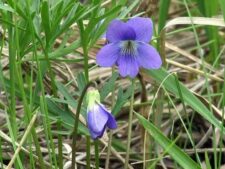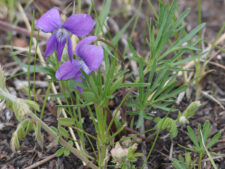
This native perennial usually grows less than 8 inches tall with deep blue, nodding flowers at the tip of a leafless stem (B). All five irregular petals have darker blue veins and white bases. The 3 lower petals also have white hairs (beards) at their bases and dark magenta “nectar” are present at the base of the middle one (A). Leaves are repeatedly divided into narrow segments (C). Ovoid seeds are produced by both conventional flowers and self-pollinating flowers which have no petals and never open.
Grows in moist to dry prairie sites, flowering in May. It is rare in Knull Prairie at Neale Woods.
Deeply divided leaves separate prairie violet from our blue-flowered woodland species.
The leaves of the prairie violet are the food source for the larvae of an important and threatened prairie butterfly, the Regal Fritillary.
The divided leaves are the source of its other common name, Crowfoot Violet.
The content of NatureSearch is provided by dedicated volunteer Naturalists of Fontenelle Forest who strive to provide the most accurate information available. Contributors of the images retain their copyrights. The point of contact for this page is: Neal Ratzlaff.

 Identification
Identification
